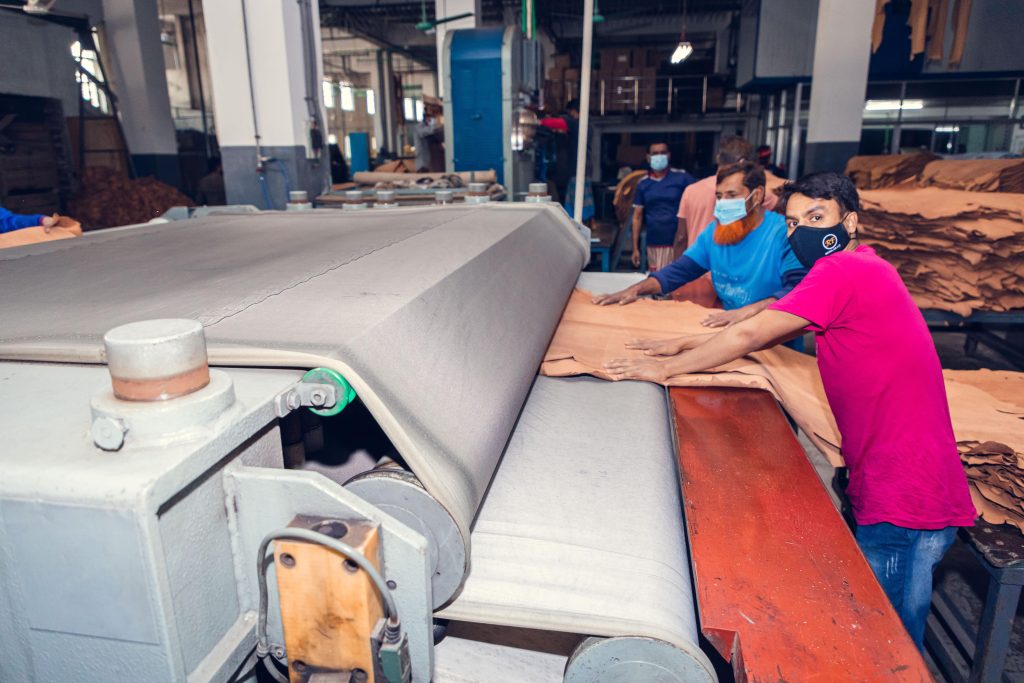
Informal Works
Lack of security in formal sector compelled street vendors to remain informal sector Street vendors are not in a position

Second-largest export sector after RMG, covering 3% of global leather & products market and 2% of footwear.
The industry employs around 0.85 million people, with 60% of the workforce being women.
Bangladesh annually produces 350 million square feet of leather, with a significant portion exported to meet foreign demand.
Labor rules and minimum wages are ignored.
Bangladesh has a long great history of undertaking the leather processing business. The leather sector in Bangladesh has three sub-sectors named as, include Tanning & Finishing, Footwear & Footwear Components, Leather Accessories, and Leather Goods (bags, wallets, belts, accessories, etc.). The leather sector is a source of exports, employment, and economic growth as well as beneficial for our whole society. The leather sector is the second-largest export sector of Bangladesh after ready-made garments. Before relocation to Savar around 200 numbers of Bangladesh’s 220 tanneries were located in the Hazaribagh area of Dhaka. At present, 155 tannery factories have been relocated to the Savar tannery estate. Around 40 small tanneries could not afford such relocation and stopped their operations. The share of the leather sector in total employment is 0.22% (in 2016).
According to Bangladesh Labour Force Survey-2013, there were 139,000 persons aged 15 or more engaged in the leather and leather goods manufacturing industries and over 50,000 people were directly or indirectly engaged in tanning industries (this engagement varies from time to time). Shifting of tannery impacted employment. The number of employments in tannery industries drops by 15% to 30%. Bangladeshi leather is extensively known around the world for its high quality and covered exports account for a mere 0.6% of the global leather (ADB, 2018). Leather footwear is the fastest-growing segment of the leather industry. Bangladesh meets the demand for about 10% of the world’s total leather market.
The main benefit of the leather industry of Bangladesh is the ample supply of raw materials. The availability of raw materials is the biggest strength of the sector. Tanneries in Bangladesh have failed to maintain Occupational Safety and Health (OSH) which is also a violation of labour rights. The workplace environment has improved in Savar more than in Hazaribagh, but it is yet to improve. The workers currently employed in tanning industries are socio-economically affected. At least 50% are daily passengers and they have to bear additional transport costs (BDT. 100 to 120 per day) as they commute to their workplaces from the capital. These costs could be avoided if they had accommodation facilities near the estate.
The family life of the female workers is in problem (e.g., cannot live with the children, look after the children, and take care of husband and other family members, some family member stays in Dhaka (Hazaribagh) and some stay in Savar). Culture of disobeying the laws and rules among the tanning industries authorities observed. Worker’s rights as mentioned in the Bangladesh Labour Act and Bangladesh Labour Rules are largely not complied with the factory management. Implementation of minimum wage declared by the government ignored. In the Leather industry, BLF is working for ensuring workplace safety and legal rights of the workers which further ensures the social compliance of the factories thus leading to certification by the LWG.

Lack of security in formal sector compelled street vendors to remain informal sector Street vendors are not in a position

Lack of security in formal sector compelled street vendors to remain informal sector Street vendors play a significant role to

Waste pickers significantly contribute to green economy but not recognized and victim of discrimination 120,000 waste pickers in Dhaka, recycled

Domestic children and women workers suffer silently in Bangladesh. Domestic workers are a highly vulnerable group in Bangladesh. High proportion
F Haque Tower, Level – 7
107, Bir Uttam C.R. Datta Road
Dhaka – 1205, Bangladesh.
© 2024 Bangladesh Labour Foundation. All Rights Reserved.
Conceptualized, Designed & Developed by-Decent Act International